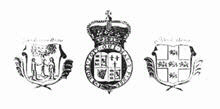The restored documents are now kept in the Institute and are
available for inspection by arrangement.
In many ways, they can be said to have "come home". One of the
signatories on the original document was Charles Yarburgh, who owned
Heslington Hall from 1754 -1789. The Hall now forms part of the
University of York
Extracted from the report by the Institute:
"A. WORK ON THE GUARDED MATERIAL FROM VOLUMES I & II
Previous condition:
The paper that had been used for binding the
swinging guards in both sets of documents was unsuitable for the method
of binding (Guarding and Filing). The guard paper was too strong and did
not flex as the sheets moved. This meant that the volumes could not
function correctly and that the pages did not lay flat when the volume
was opened. Many of the guards were badly affixed to the original
documents and in some cases the guard was covering the original text.
Work carried out:
The page numbering was first checked and a note
made of any discrepancies. The main task of removing the guards was then
undertaken. This took some time since the adhesive used was difficult to
remove. Traces of a PVA type adhesive was found, which can at
times prove almost impossible to remove without causing damage to the
originals. A more sympathetic adhesive such as a starch based adhesive
would have been more in keeping with a conservation / binding method
such as had been used.Both sets of separate pages were then
placed into purpose-made folders and these in turn placed onto a box for
safe storage.
Previous condition:
The earliest volume had been bound in
with the first set of "loose" papers. The guards from this volume and
the single sheet material meant that the volume could not be consulted
without possible damage to the text. The method used to bind this early
volume is known as reverse guard binding, and once again the method
relies on the flexibility of the guard paper.
Work carried out:
The sections of the early volume were stripped
from the binding. There were 6 sections with various numbers of leaves
in each. The pages were numbered 1 -152 (no new numbering was added). It
was found that the previous repair work on the spines of the folds was
inadequate so the spines were reinforced with coated Nylon to enable the
section to withstand sewing and subsequent usage. Each section was then
sewn on to a single sheet of repair paper which was also reinforced with
Nylon on the reverse, to allow the section and guard to swing freely in
use. Compensating guards were made and these are interspersed between
the section guards to allow for a spine to be produced. The whole volume
was then stab stitched.
A spine and shoulders were created and new custom-made front and back
boards were attached. The volume was then covered in dark brown calf as
per the owners' instructions."
Borthwick Institute for Archives;
Nov 2006





